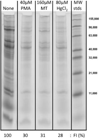Organic and inorganic mercurials have distinct effects on cellular thiols, metal homeostasis, and Fe-binding proteins in Escherichia coli
- PMID: 26498643
- PMCID: PMC4749482
- DOI: 10.1007/s00775-015-1303-1
Organic and inorganic mercurials have distinct effects on cellular thiols, metal homeostasis, and Fe-binding proteins in Escherichia coli
Abstract
The protean chemical properties of the toxic metal mercury (Hg) have made it attractive in diverse applications since antiquity. However, growing public concern has led to an international agreement to decrease its impact on health and the environment. During a recent proteomics study of acute Hg exposure in E. coli, we also examined the effects of inorganic and organic Hg compounds on thiol and metal homeostases. On brief exposure, lower concentrations of divalent inorganic mercury Hg(II) blocked bulk cellular thiols and protein-associated thiols more completely than higher concentrations of monovalent organomercurials, phenylmercuric acetate (PMA) and merthiolate (MT). Cells bound Hg(II) and PMA in excess of their available thiol ligands; X-ray absorption spectroscopy indicated nitrogens as likely additional ligands. The mercurials released protein-bound iron (Fe) more effectively than common organic oxidants and all disturbed the Na(+)/K(+) electrolyte balance, but none provoked efflux of six essential transition metals including Fe. PMA and MT made stable cysteine monothiol adducts in many Fe-binding proteins, but stable Hg(II) adducts were only seen in CysXxx(n)Cys peptides. We conclude that on acute exposure: (a) the distinct effects of mercurials on thiol and Fe homeostases reflected their different uptake and valences; (b) their similar effects on essential metal and electrolyte homeostases reflected the energy dependence of these processes; and (c) peptide phenylmercury-adducts were more stable or detectable in mass spectrometry than Hg(II)-adducts. These first in vivo observations in a well-defined model organism reveal differences upon acute exposure to inorganic and organic mercurials that may underlie their distinct toxicology.
Keywords: EPR; EXAFS; Electrolyte balance; Metal toxicity; Proteomics.
Figures





References
-
- Barkay T, Miller SM, Summers AO. FEMS Microbiol Rev. 2003;27:355–384. - PubMed
-
- Mason RP, Fitzgerald WF, Morel FMM. Geochimica Et Cosmochimica Acta. 1994;58:3191–3198.
-
- Norn S, Permin H, Kruse E, Kruse PR. Dan Medicinhist Arbog. 2008;36:21–40. - PubMed
-
- Crinnion WJ. Altern Med Rev. 2000;5:209–223. - PubMed
-
- Richardson GM, Wilson R, Allard D, Purtill C, Douma S, Graviere J. Sci Total Environ. 2011;409:4257–4268. - PubMed
Publication types
MeSH terms
Substances
Grants and funding
LinkOut - more resources
Full Text Sources
Other Literature Sources
Medical

